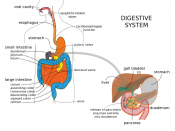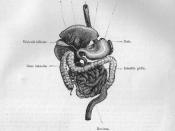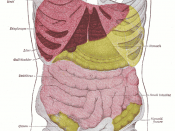Human Digestion Summary
Our digestive system is made up of what is called the digestive tract. The digestive tract is made up of different hollow organs that are joined in a long, twisting tube that goes from the mouth all the way to the anus, also to other organs that help our body break down and absorb food that we eat. The mouth, esophagus, stomach, small intestine and large intestine (the colon-rectum and anus), are the organs that make up the digestive tract. Inside of these hollow organs there is a lining, this is called the mucosa. In the mouth, small intestine, and in the stomach, the mucosa contains small glands that produce juices that help us digest our food.
The digestive tract also contains a layer of smooth muscle that is there to help break down food and to move it along the tract. Two of our solid digestive organs are the liver and the pancreas.
They both create digestive juices that reach the intestines through little tubes called ducts. The gallbladder is what stores the liver's digestive juices until they are needed in the intestine. Some parts of our circulatory and nervous systems play a big role in the digestive system.
Digestion is the process by which food and drinks are broken down into their tiniest. When they are broken down into their tiniest so that the body can then use them to build and nourish cells and to provide energy. Salivary glands are what begin the digestive process. After the food enters the mouth it is moistened by the saliva and then chewed by the teeth, and it is transformed into a bolus. When the bolus leaves the mouth, it then moves into the pharynx, where it can then be swallowed.


